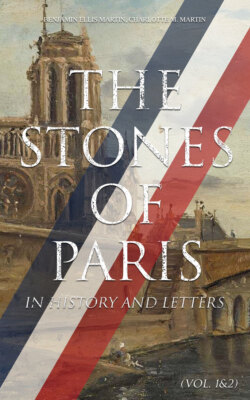The Stones of Paris in History and Letters (Vol. 1&2)

Реклама. ООО «ЛитРес», ИНН: 7719571260.
Оглавление
Benjamin Ellis Martin. The Stones of Paris in History and Letters (Vol. 1&2)
The Stones of Paris in History and Letters (Vol. 1&2)
Table of Contents
VOLUME 1
INTRODUCTORY
THREE TIME-WORN STAIRCASES
THE SCHOLARS' QUARTER OF THE MIDDLE AGES
MOLIÈRE AND HIS FRIENDS
FROM VOLTAIRE TO BEAUMARCHAIS
THE PARIS OF THE REVOLUTION
VOLUME 2
THE SOUTHERN BANK IN THE NINETEENTH CENTURY
THE PARIS OF HONORÉ DE BALZAC1
THE PARIS OF ALEXANDRE DUMAS
THE PARIS OF VICTOR HUGO
THE MAKING OF THE MARAIS
THE WOMEN OF THE MARAIS
FOOTNOTE
Отрывок из книги
Benjamin Ellis Martin, Charlotte M. Martin
Study of the French Capital
.....
His body rests in his parish church, a few steps farther on, through ancient Rue Saint-Victor, now curtailed and mutilated. Along its line, before we come to the square tower of Saint-Nicolas-du-Chardonnet, we skirt the dirty yellow and drab wall of the famous seminary alongside the church, and bearing its name. Its entrance is at No. 30 Rue de Pontoise, and among the many famous pupils who have gone in and out since Calvin was a student here, we may mention only Ernest Renan. In 1838, the director of the school being the accomplished Dupanloup, this boy of fifteen came fresh from Brittany to his studies here. We shall follow him to his later and larger schools, in other pages. When Jean "le Moine," the son of a Picardy peasant, came to sit in a cardinal's chair, and was sent to Paris as legate by Pope Boniface VIII., he established a great college in the year 1303. For it he bought the chapel, the dwellings, and the cemetery of the Augustins that were all in fields of thistles. So came the name "du Chardonnet" to the church now built on the ruins of Lemoine's chapel, in the later years of the seventeenth century. Lebrun decorated one of its chapels for the burial of his mother, and his own tomb is there near hers. Some of his work still shows on the ceiling; and in an adjacent chapel, in odd proximity, once hung a canvas from the brush of Mignard. In striking contrast, the busts of the two men face each other in the Louvre; that of Mignard is alert with intelligence in face and poise of head, while Lebrun's suggests a somewhat slow-witted earnestness.
From this short stay in the realm of Louis the Unreal, we go to the island that bears the name of the Louis who was called a saint, but who was a very real man. All the streets along here that take us to the river, as far easterly as the one that bears the name of Cardinal Lemoine, were cut through the grounds of his college and of the Bernadins, an ancient foundation alongside. Of the buildings of this vast monastery, the refectory remains, behind the wall on the western side of Rue de Poissy. This characteristic specimen of thirteenth-century architecture, but little spoiled by modern additions, is used for the caserne of the Sapeurs-Pompiers. Here, at the foot of the street on the river-bank on our right, is the great space where Boulevard Saint-Germain comes down to the quay, and where the old wall came down to its great tower on the shore. On our left, as we cross broad Pont de la Tournelle, we get an impressive view of Notre-Dame. And now we find ourselves in a provincial town, seemingly far removed from our Paris in miles and in years, by its isolation and tranquillity and old-world atmosphere. Its long, lazy main street is named after the royal saint, and its quays keep the titles of royal princes, Bourbon, Orléans, Anjou. A great royal minister, Maximilien de Béthune, gives his name to another quay, and his great master gives his to the new boulevard crossing it. Henry often crossed his faithful Sully, but they were at one in the orders issued, in the year before the King's murder, for the sweeping away of the woodyards, that made this island the storehouse of the town's timber, and for the construction of these streets and buildings. The works planned by Henri IV. were carried out by Marie de' Medici and Louis XIII. A concession was given for the laying out of streets and for the buildings on this island, and for the construction of a new stone bridge to the Marais, to the three associates, Marie, Le Regrettier, Poultier, who gave their names to the bridge and to two of the streets. There was already a small chapel in the centre, the scene of the first preaching of the First Crusade, and this chapel has been enlarged to the present old-time parish church. Just within its entrance is the bénitier, filled with water from the mouth of a marble cherub who wears a pretty marble "bang." It came from the Carmelites of Chaillot, in souvenir of "Sister Louise."
.....